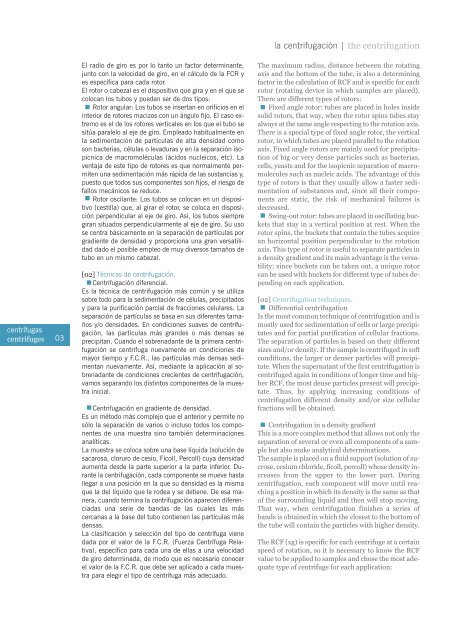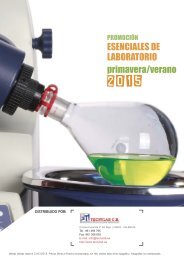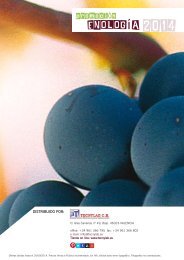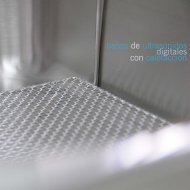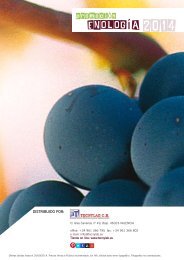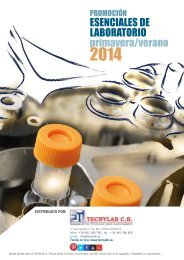o_18rmolofuub214r7136uoko1amua.pdf
Create successful ePaper yourself
Turn your PDF publications into a flip-book with our unique Google optimized e-Paper software.
centrífugas<br />
centrifuges 03<br />
El radio de giro es por lo tanto un factor determinante,<br />
junto con la velocidad de giro, en el cálculo de la FCR y<br />
es específica para cada rotor.<br />
El rotor o cabezal es el dispositivo que gira y en el que se<br />
colocan los tubos y pueden ser de dos tipos:<br />
Rotor angular: Los tubos se insertan en orificios en el<br />
interior de rotores macizos con un ángulo fijo. El caso extremo<br />
es el de los rotores verticales en los que el tubo se<br />
sitúa paralelo al eje de giro. Empleado habitualmente en<br />
la sedimentación de partículas de alta densidad como<br />
son bacterias, células o levaduras y en la separación isopícnica<br />
de macromoléculas (ácidos nucleicos, etc). La<br />
ventaja de este tipo de rotores es que normalmente permiten<br />
una sedimentación más rápida de las sustancias y,<br />
puesto que todos sus componentes son fijos, el riesgo de<br />
fallos mecánicos se reduce.<br />
Rotor oscilante: Los tubos se colocan en un dispositivo<br />
(cestilla) que, al girar el rotor, se coloca en disposición<br />
perpendicular al eje de giro. Así, los tubos siempre<br />
giran situados perpendicularmente al eje de giro. Su uso<br />
se centra básicamente en la separación de partículas por<br />
gradiente de densidad y proporciona una gran versatilidad<br />
dado el posible empleo de muy diversos tamaños de<br />
tubo en un mismo cabezal.<br />
[02] Técnicas de centrifugación.<br />
Centrifugación diferencial.<br />
Es la técnica de centrifugación más común y se utiliza<br />
sobre todo para la sedimentación de células, precipitados<br />
y para la purificación parcial de fracciones celulares. La<br />
separación de partículas se basa en sus diferentes tamaños<br />
y/o densidades. En condiciones suaves de centrifugación,<br />
las partículas más grandes o más densas se<br />
precipitan. Cuando el sobrenadante de la primera centrifugación<br />
se centrifuga nuevamente en condiciones de<br />
mayor tiempo y F.C.R., las partículas más densas sedimentan<br />
nuevamente. Así, mediante la aplicación al sobrenadante<br />
de condiciones crecientes de centrifugación,<br />
vamos separando los distintos componentes de la muestra<br />
inicial.<br />
Centrifugación en gradiente de densidad.<br />
Es un método más complejo que el anterior y permite no<br />
sólo la separación de varios o incluso todos los componentes<br />
de una muestra sino también determinaciones<br />
analíticas.<br />
La muestra se coloca sobre una base líquida (solución de<br />
sacarosa, cloruro de cesio, Ficoll, Percoll) cuya densidad<br />
aumenta desde la parte superior a la parte inferior. Durante<br />
la centrifugación, cada componente se mueve hasta<br />
llegar a una posición en la que su densidad es la misma<br />
que la del líquido que le rodea y se detiene. De esa manera,<br />
cuando termina la centrifugación aparecen diferenciadas<br />
una serie de bandas de las cuales las más<br />
cercanas a la base del tubo contienen las partículas más<br />
densas.<br />
La clasificación y selección del tipo de centrífuga viene<br />
dada por el valor de la F.C.R. (Fuerza Centrífuga Relativa),<br />
específico para cada una de ellas a una velocidad<br />
de giro determinada, de modo que es necesario conocer<br />
el valor de la F.C.R. que debe ser aplicado a cada muestra<br />
para elegir el tipo de centrífuga más adecuado.<br />
The maximum radius, distance between the rotating<br />
axis and the bottom of the tube, is also a determining<br />
factor in the calculation of RCF and is specific for each<br />
rotor (rotating device in which samples are placed).<br />
There are different types of rotors:<br />
Fixed angle rotor: tubes are placed in holes inside<br />
solid rotors, that way, when the rotor spins tubes stay<br />
always at the same angle respecting to the rotation axis.<br />
There is a special type of fixed angle rotor, the vertical<br />
rotor, in which tubes are placed parallel to the rotation<br />
axis. Fixed angle rotors are mainly used for precipitation<br />
of big or very dense particles such as bacterias,<br />
cells, yeasts and for the isopicnic separation of macromolecules<br />
such as nucleic acids. The advantage of this<br />
type of rotors is that they usually allow a faster sedimentation<br />
of substances and, since all their components<br />
are static, the risk of mechanical failures is<br />
decreased.<br />
Swing-out rotor: tubes are placed in oscillating buckets<br />
that stay in a vertical position at rest. When the<br />
rotor spins, the buckets that contain the tubes acquire<br />
an horizontal position perpendicular to the rotation<br />
axis. This type of rotor is useful to separate particles in<br />
a density gradient and its main advantage is the versatility;<br />
since buckets can be taken out, a unique rotor<br />
can be used with buckets for different type of tubes depending<br />
on each application.<br />
[02] Centrifugation techniques.<br />
Differential centrifugation<br />
Is the most common technique of centrifugation and is<br />
mostly used for sedimentation of cells or large precipitates<br />
and for partial purification of cellular fractions.<br />
The separation of particles is based on their different<br />
sizes and/or density. If the sample is centrifuged in soft<br />
conditions, the larger or denser particles will precipitate.<br />
When the supernatant of the first centrifugation is<br />
centrifuged again in conditions of longer time and higher<br />
RCF, the most dense particles present will precipitate.<br />
Thus, by applying increasing conditions of<br />
centrifugation different density and/or size cellular<br />
fractions will be obtained.<br />
Centrifugation in a density gradient<br />
This is a more complex method that allows not only the<br />
separation of several or even all components of a sample<br />
but also make analytical determinations.<br />
The sample is placed on a fluid support (solution of sucrose,<br />
cesium chloride, ficoll, percoll) whose density increases<br />
from the upper to the lower part. During<br />
centrifugation, each component will move until reaching<br />
a position in which its density is the same as that<br />
of the surrounding liquid and then will stop moving.<br />
That way, when centrifugation finishes a series of<br />
bands is obtained in which the closest to the bottom of<br />
the tube will contain the particles with higher density.<br />
The RCF (xg) is specific for each centrifuge at a certain<br />
speed of rotation, so it is necessary to know the RCF<br />
value to be applied to samples and chose the most adequate<br />
type of centrifuge for each application:


